Step into the shoes of the Curiosity Rover as it journeys across Mars, capturing the rugged beauty of ‘Marker Band Valley’, revealing secrets of the Red Planet’s geological past.
A mesmerizing new image captured by NASA’s Curiosity Rover has been released, providing a captivating glimpse into Mars’ intriguing past. Dubbed “Marker Band Valley,” this stunning picture offers a highly detailed view of the three-mile high central peak located within Gale Crater on the Red Planet’s surface.
The Curiosity Rover, tirelessly exploring Mars since 2012, took this awe-inspiring ‘postcard’ back in April as part of its ongoing mission to unravel the planet’s climate, geology, and potential evidence of water.
Marker Band Valley is a winding geological feature nestled in the foothills of Mount Sharp, also known as ‘Aeolis Mons.’ Notably, NASA’s findings have unveiled surprising indications of an ancient lake in this area, as reported by The Daily Express US.
In the foreground of this captivating image, expertly created by combining images from various stages of the Martian day, one can witness the tracks left behind by the rover as it emerges from the valley.
“The postcard is an artistic interpretation of the landscape,” as explained by NASA, “with color added over two black-and-white panoramas captured by Curiosity’s navigation cameras.”
The right-hand side of the image, taken at 9:20 a.m. local Mars time on April 8 of this year, contrasts with the left side, captured at 3:40 p.m. on the same day.
These carefully planned and processed images were skillfully created by engineer Doug Ellison from NASA’s Jet Propulsion Laboratory in Southern California. Ellison highlights the profound impact of varying lighting conditions, enabling features of interest to stand out more prominently.

Ellison explains, drawing an analogy to the changing scenery experienced in national parks, “Anyone who’s been to a national park knows the scene looks different in the morning than it does in the afternoon. Capturing two times of day provides dark shadows because the lighting is coming in from the left and the right, like you might have on a stage. But instead of stage lights, we’re relying on the Sun.”
The captivating depth of shadows depicted in these images can be attributed to the timing of Curiosity’s shots, coinciding with the local winter on the planet. During this season, airborne dust levels significantly decrease, allowing for sharper and more pronounced shadows.
As explained by Ellison “Mars’ shadows get sharper and deeper when there’s low dust and softer when there’s lots of dust.”
This interplay between dust levels and shadow intensity adds a mesmerizing dimension to the composite image.

To create each of the two panoramas used in the composite, Curiosity diligently captured a series of five images, with each panorama requiring approximately seven-and-a-half minutes of observation time. These images were then transmitted back to Earth for a meticulous editing process, where they were expertly stitched together.
In the backdrop of these captivating views, the rim of Gale Crater emerges, visible from a distance of about 25 miles. This grand geological feature adds context and scale to the composite image, providing a glimpse into the vastness of Mars’ landscape.
It is the unique combination of Mars’ winter conditions, reduced airborne dust, and the meticulous efforts of the Curiosity Rover and the editing team on Earth that have resulted in these remarkable images with captivating shadow depths.
NASA added, “Because skies were so clear, a mountain beyond the crater rim can be seen, even though it’s 54 miles outside of Gale.”
In the forefront of the image, one can catch a glimpse of the Curiosity rover’s three communication antennas, alongside its nuclear power source.
Furthermore, occupying the bottom right corner is a white circle representing the Radiation Assessment Detector, abbreviated as “RAD,” an instrument that holds the potential to protect the well-being of future Mars-bound astronauts by providing crucial data.
Image Credit: NASA
